 For 12 days this spring I took part in the toughest karate camp in the world, hosted by Kyokushin karate icon Judd Reid in Thailand.
For 12 days this spring I took part in the toughest karate camp in the world, hosted by Kyokushin karate icon Judd Reid in Thailand.
While Reid may not be a household name in the United States, he is in the world of karate, as well as in his home country of Australia. At only 19 years old, Reid was honored with an invitation to the Uchi Deshi (live-in student) program under the legendary Master Sosai Mas Oyama in Japan. There, he would train in Kyokushin -- which translates to "the ultimate truth" in Japanese -- karate for 1,000 days straight under the most exacting and Spartan conditions.
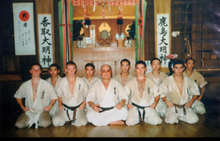 Reid completed the 1,000 days as a "Young Lion," the first non-Japanese student ever to do so and still one of only two foreigners to accomplish the feat. He went on to a professional fighting career and after a string of second and third place finishes, finally broke through in 2010 at the improbable age of 39 by winning the World Championship of Karate belt.
Reid completed the 1,000 days as a "Young Lion," the first non-Japanese student ever to do so and still one of only two foreigners to accomplish the feat. He went on to a professional fighting career and after a string of second and third place finishes, finally broke through in 2010 at the improbable age of 39 by winning the World Championship of Karate belt.
Not satisfied to fade into the sunset with his championship credentials, at 40 years old Reid honored his promise to his Master by undertaking the 100-Man Fight, a real-life kumite where he had to fight 100 black belts in a row in bare-knuckle matches. He successfully fought his way through the one hundred -- as seen in the documentary 100-Man Fight -- one of only 18 martial artists ever to accomplish the task.
Now retired from professional fighting, Reid enjoys teaching Kyokushin karate and spreading the principles of honor and discipline instilled in him by the late Master Oyama, who passed in 1994.
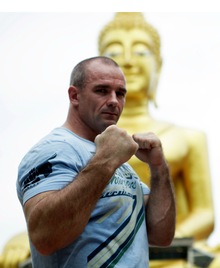
Having been friendly with Reid for a couple years through mutual friends in Asia, I jumped on the chance to come to Thailand to train at his first camp. It was located in Jomtien, right outside Pattaya -- considered the Las Vegas of the nation. But our camp was comfortably sequestered at a hotel on Hu-Gwang Bay in Jomtien, with sprawling lawns, palm trees, and a private beach that reminded me of Hawaii.
The participants arrived separately, flying in from far reaching points like Australia, New Zealand, England, India, Belgium, Scotland -- and one American who happened to be living in neighboring Cambodia for the year (me). There were thirteen participants in all; both men and women; the majority of them black belts, with a few well-practiced brown or red belts mixed in and only three white belts.
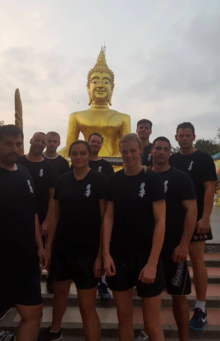 For 12 grueling and gratifying days, Shihan Reid put us through a condensed version of his beloved Uchi Deshi program with three-a-day workouts. We first met early in the morning for a workout at dawn, then one at 11am, and again at either 3:30 or 5pm.To survive thirty-six training sessions; that was the mountainous task we were charged with. Reid explained that the average karate student or martial artist might get in three good trainings per week back at home, so with three workouts a day for twelve days, we were essentially fitting in three months of training into less than two weeks.
For 12 grueling and gratifying days, Shihan Reid put us through a condensed version of his beloved Uchi Deshi program with three-a-day workouts. We first met early in the morning for a workout at dawn, then one at 11am, and again at either 3:30 or 5pm.To survive thirty-six training sessions; that was the mountainous task we were charged with. Reid explained that the average karate student or martial artist might get in three good trainings per week back at home, so with three workouts a day for twelve days, we were essentially fitting in three months of training into less than two weeks.
The location of the workouts alternated between the small strip of private beach down a series of stone steps, in the dojo set up in a hotel conference hall, and some on the manicured mint-green lawn.
We wore our assigned black Uchi Deshi camp t-shirts, shorts and running sneakers for most morning sessions, but most of the training was done in our gi's, which were always wet with sweat and seawater because many of the exercises were done waist-deep in the ocean. Reid and his co-instructor, Dean Booth, often rallied us with chants of "Osu!" -- a traditional Kyokushin call-and-response.
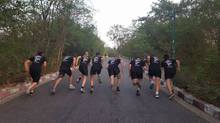 Some early mornings were even spent sprinting up the steep hills by a nearby Buddha statue and Pagoda (Buddhist temple), our gasping, sweat-soaked and shaky-legged crew forgetting how much pain we were in when we saw the Thai coastline from the lookout at top.
Some early mornings were even spent sprinting up the steep hills by a nearby Buddha statue and Pagoda (Buddhist temple), our gasping, sweat-soaked and shaky-legged crew forgetting how much pain we were in when we saw the Thai coastline from the lookout at top.
I was a complete karate neophyte but I've dabbled in boxing training and enough Muay Thai and Cambodian Khun Khmer to know my future is with a pen, not with my fists. But I thought I'd be ok -- after all, wasn't karate a rigid and relatively sedentary form of martial arts, consisting mostly of choreographed katas and drills? It only took 15 minutes into the first training session for me to find out that couldn't be more untrue -- and to be thoroughly humbled.
"It's important that you are in shape first, and then technically trained second. But if you aren't in shape, none of that will matter," said Reid.
Another one of my misconceptions was that karate wasn't a very tough martial art since there were no head punches in tournaments and sparring. While there may not be fist strikes to the head in Kyokushin karate tournaments (though we often threw high punches during drills to simulate real life situations), you can still kick full force to the head or the body, as well as elbow, knee, and punch to the body as hard as you'd like -- all of this bare knuckled.
But unlike boxing or other forms of kickboxing, there is far less measuring and engaging your opponent from distance -- less dancing, essentially. In fact, Kyokushin karate fighters take pride in not moving backwards, part of their philosophy of never showing weakness, fear or surrendering.
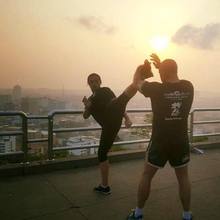 So what it amounts to are two very skilled, insanely flexible and powerful athletes completely teeing off on each other, staying in range and trading full-on punches to the chest, shoulders, sternum, ribs and gut, mixed in with some knees to the midsection, and explosive kicks to the head or chopping down across thighs that rattle you to the bone.
So what it amounts to are two very skilled, insanely flexible and powerful athletes completely teeing off on each other, staying in range and trading full-on punches to the chest, shoulders, sternum, ribs and gut, mixed in with some knees to the midsection, and explosive kicks to the head or chopping down across thighs that rattle you to the bone.
I learned this all-too-quickly on the first day when we had to spar. But instead of matching up white belts against white belts, etc. we went down the line so everyone sparred everyone else.
I managed to counterpunch and gasp my way through the first two opponents without passing out, and then was paired with Sebastien, a ripped black belt from Belgium. In sheer panic, I employed the old boxing trick of stepping on his foot as I threw a punch to keep him from moving. He just smiled and said, "Try that again," and unleashed a kick that started at my thigh. But as I curled to absorb the blow and dropped my hands (the absolute wrong thing to do), his foot redirected in mid-flight, snapping up at my head but mercifully stopping inches from my exposed face.
But this was not a blood sport meant to hurt or demean the neophytes -- or anyone. It was all so we could learn and grow as fighters and athletes. Shihan Reid knew exactly whom to push, and when, frequently stopping to correct our technique, explaining the philosophy behind an attack or defense, or adjusting the intensity level.
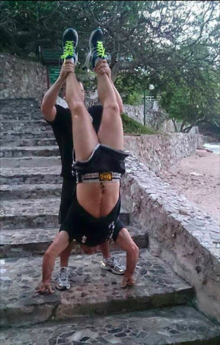
Our footwork was the foundation to everything, far more important than unloading strong punches or dazzling kicks. He explained that you have to have a strong stance, like the roots of a great tree, because that is where you draw all your power and balance, but at the same time you need to be loose and agile -- quick to move to create angles, set up an attack, or block an opponent's kick.
"You watch your opponent; stalk them like prey," Reid said. Even our defense was turned into offense, as well-conditioned shins and forearms could not only deflect blows but cause pain to our attackers. "If your opponent throws something against you, make them pay for it," Reid said.
Just watching him demonstrate the techniques was worth the price of admission, like witnessing Kobe Bryant practice three pointers or the Rolling Stones do a sound check. I've never seen a combination of muscle, flexibility, and perfectly honed technique like with Reid. There was artistry in the violence of his punches that pierced mid-air, the snap of his gi so sharp when he kicked that I thought it might start smoking.
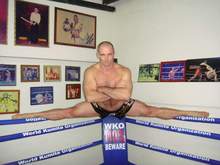 One morning Reid demonstrated a leg kick and had Booth hold the kick shield. The sound of his shin smacking the pad literally left my ears ringing for thirty seconds afterwards. I've never in my life heard someone hit that hard -- or with that scalpel precision.
One morning Reid demonstrated a leg kick and had Booth hold the kick shield. The sound of his shin smacking the pad literally left my ears ringing for thirty seconds afterwards. I've never in my life heard someone hit that hard -- or with that scalpel precision.
As the days rolled on, sprinting up steep hills, handstand pushups, squatting or walking up stairs while carrying each other, and endless pushups and sit-ups in the sand were the norm. We counted together in Japanese as we went through our stretching routine or drilled sequences of punches and kicks.
Shihan Reid drew from several fountains of knowledge as he taught us: the traditional Kyokushin karate attacks; what he'd learned fighting professionally, and rounding it out with tips from boxing, Judo, Muay Thai, or even street fighting. He often shared fighting philosophies and personal stories of life in Mas Oyama's 1,000-day program.
It was hard to imagine 1,000 days of this -- and our camp was a light version of what Reid had endured. Indeed, survival became the name of the game for all of us. We limped stiffly through the hotel lobby, and relished the chance to recover by sleeping or relaxing by the pool every minute we weren't training (except the writers among us, who still kept their 50-hour a week workload through half-closed eyelids), and threw punches in our sleep.
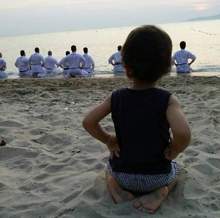 But Reid was tolerant of injuries, asking how everyone was, and checking our knuckles daily to make sure there wasn't too much carnage (and that we were striking with the first two knuckles). We were ultra-focused while training but it was by no means an army boot camp. There was plenty of encouragement and even moments of levity.
But Reid was tolerant of injuries, asking how everyone was, and checking our knuckles daily to make sure there wasn't too much carnage (and that we were striking with the first two knuckles). We were ultra-focused while training but it was by no means an army boot camp. There was plenty of encouragement and even moments of levity.
One of the first days, we were throwing punches while standing up to our chests in the ocean during the sunset training session when a school of small flying fish skipped by before dipping into the waves -- an incredible site. The next day, Reid confessed to me that once he'd got back to his room that evening and taken off his gi, a fish had fallen out of his karate pants. Sunset training sessions had a family atmosphere as Reid's wife and son watched and snapped photos, little Max in his own miniature karate gi imitating our kicks.
When an American UFC fight was live on Thai television at 10 in the morning, we all watched together. Two very capable female fighters duked it out on the undercard, and I took the opportunity to pose a rhetorical question to Reid:
"See these women fighting now? Ok, if I had to fight one of them but they could only use one hand, and you bet all the money you had in the world, who would you bet on?"
"You, of course," he said in his rugged Aussie accent, as if there was no doubt.
"Really? You would?"
"Yeah, mate."
"Wow, I'm surprised," I said.
"Well, money isn't everything in life," he said, to which I almost fell out of my chair laughing.
Later on during that same event, Nate Diaz shocking the world by knocking out Connor McGregor after getting roughed-up in the early going. Reid was impressed by Diaz's die-hard spirit.
"See -- you don't panic. You stick in there, stick in there, you survive, and soon you'll get your chance. Your opponent is human, too."
Eight days in, when everyone was sore and fatigued beyond limits, Reid knew just when to rest us, packing the group on a bus for a relaxing sightseeing trip in the Thai countryside for the day.
"Saturday meals were harder than training," Reid said as ordered dish after dish at one of his favorite Thai restaurants. He explained that on Saturday evenings, Master Oyama's Uchi Deshi students got a break from the monotony and rigors of training with a special meal. The young students were encouraged to eat way, a force-feeding frenzy. It was a mental test as much as a way to reinvigorate the students, so when Master Oyama asked if they wanted more, no one dared decline.
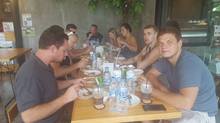 So Reid did the same with us, ordering enough maddeningly-spicy papaya salad, steaming noodles, barbecue chicken, curries, and a few unidentifiable Thai dishes to feed a group twice our size. Even when we protested that we couldn't swallow another bite, he dished more onto our plates, until it was all gone.
So Reid did the same with us, ordering enough maddeningly-spicy papaya salad, steaming noodles, barbecue chicken, curries, and a few unidentifiable Thai dishes to feed a group twice our size. Even when we protested that we couldn't swallow another bite, he dished more onto our plates, until it was all gone.
"Master Oyama went to the top of a mountain to train by himself for three years -- that is where the 1,000 days comes from," Reid said, his face softening as he replayed the home movie of his master speaking in his head. "He used to tell us that the worst things in life were not having enough to eat, and being lonely," he reflected. "Being hungry and being alone."
As the camp progressed, the fighters grew closer and formed a mutual respect. But our camaraderie was forged in silence while training -- the preferred language, action. And although our bodies rebelled, we pushed on.
Still, the attrition rate was high. One fighter succumbed to stomach flu, another black belt was struck with gout in his foot, and an old knee injury crippled another.
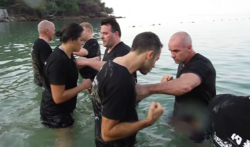 I felt a sharp pain in my ribs after trading punches with a behemoth black belt one of the first days, but everything hurt so I didn't think much of it. But four days later, when the knuckle-shaped bruises were even more pronounced and I couldn't sleep or take a full breath because the pain was so bad, I knew something was wrong. A quick taxi ride to the hospital in Pattaya and an x-ray later (by the way, Thai healthcare is great and shockingly inexpensive) I found out I had at least one broken rib, and maybe three.
I felt a sharp pain in my ribs after trading punches with a behemoth black belt one of the first days, but everything hurt so I didn't think much of it. But four days later, when the knuckle-shaped bruises were even more pronounced and I couldn't sleep or take a full breath because the pain was so bad, I knew something was wrong. A quick taxi ride to the hospital in Pattaya and an x-ray later (by the way, Thai healthcare is great and shockingly inexpensive) I found out I had at least one broken rib, and maybe three.
"You can't exercise or do anything strenuous for two months," the doctor said. "You have to let it heal properly or the rib will further separate."
I skipped the workout that afternoon, my diagnosis a convenient excuse to sit out the rest of the camp. Of course no one would blame me. I drank a beer and watched the tourists go by.
But suddenly, I realized how much I'd miss the pre-dawn wake ups to go sprinting up hills until my lungs were on fire. I missed the feel of my heavy, wet gi. I missed the collective chants of my camp-mates "Fight-o! Fight-O!" as we ran down the beach at sunset.
I stood up, paid for my half-finished beer and went back to the hotel. I might not be in good shape or well-trained like the other fighters, but I wasn't done yet -- I wouldn't give up.
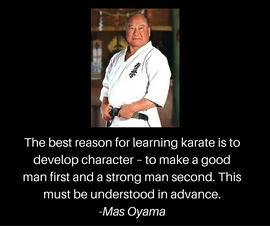 Far past the limits of the body and even when your brain is screaming "stop," you reach a place where it doesn't matter. It doesn't matter how much it hurts or how monumental or impossible the task seems because as long as you have air in your lungs, you're going to continue. In the end, you are really competing with yourself, and that is the only person you have to answer to. It's not a choice anymore, it's a decision, and you decide never to surrender -- the true meaning of Osu!
Far past the limits of the body and even when your brain is screaming "stop," you reach a place where it doesn't matter. It doesn't matter how much it hurts or how monumental or impossible the task seems because as long as you have air in your lungs, you're going to continue. In the end, you are really competing with yourself, and that is the only person you have to answer to. It's not a choice anymore, it's a decision, and you decide never to surrender -- the true meaning of Osu!
I showed up to the next workout, and the next, and didn't miss one more the rest of the camp. Of course I was cautious with the rib and only did exercises that wouldn't reinjure it, but I showed up; I didn't quit.
For all of us, the results showed. While we maybe only could do 15 pushups on our knuckles the first day, we now grunted out 40. Our kicks were higher and more fluid, the punches and combinations crisper. Our shins no longer smarted when we blocked a kick. We looked forward being punched in the stomach rapid fire to condition our core. Our movements became instinctual and our stances deepened into a power source we never knew existed.
Soon, the 12 days that felt like 30 were done. The camp concluded with a formal ceremony where we were awarded Uchi Deshi certificates of completion from the Chikara Kyokushin karate organization, Reid bowing proudly to each of us. We ate one last epic meal together overlooking the ocean at sunset before going our separate ways the next day -- and no one declined when offered more food.
 I realized that this is what Reid wanted to convey to use the whole time. He wasn't just training us in karate; he was trying to give us a gift -- the gift of discipline, of hard work, virtue and honor. It was still up to us to earn it, but now we had belief in ourselves past all doubts, a fighting spirit that would serve us whatever dreams we hoped to achieve in life. It was the same gift that had changed his life when he was a 19-year old kid heading to Japan with only a suitcase and a fire in his belly.
I realized that this is what Reid wanted to convey to use the whole time. He wasn't just training us in karate; he was trying to give us a gift -- the gift of discipline, of hard work, virtue and honor. It was still up to us to earn it, but now we had belief in ourselves past all doubts, a fighting spirit that would serve us whatever dreams we hoped to achieve in life. It was the same gift that had changed his life when he was a 19-year old kid heading to Japan with only a suitcase and a fire in his belly.
"To master yourself is to master the whole world," Master Oyama had told him. That was the most important task of all, one that took a lifetime of dedication -- and why this was the toughest karate camp on earth.
Osu!
To watch a short video of the fight camp, click here. Or visit ThailandKarateCamps.com for more information.